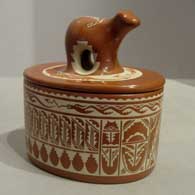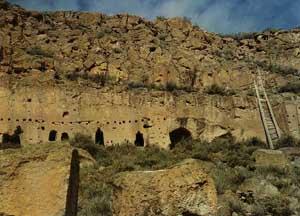
Dolores Curran
Santa Clara

Dolores Curran was born in 1954 to potters Ursulita and Alfred Naranjo of Santa Clara Pueblo. She is the granddaughter of Marie Suazo, sister of Geri Naranjo and aunt of Kevin Naranjo.
Dolores worked for three years as a bookkeeper for the State of New Mexico after graduating from the University of New Mexico. After her daughter Ursula was born, she turned to making pottery full time so she'd have time to spend with her daughter. Dolores was married to Alvin Curran from San Juan Pueblo for more than seventeen years and the cross-pollination of San Juan and Santa Clara pottery styles has had a significant influence on her own style.
A master potter, she creates her work in the traditional way: gathering all the raw materials she needs from the Santa Clara Pueblo area and firing her pottery outdoors using cedar and piñon pine in a tin firebox. Well known for her redware and her traditional black-on-black etched pots, she uses traditional Santa Clara elements of design like the water serpent (avanyu), feathers, clouds and kiva steps. Her extraordinary attention to detail, obvious in her stone polishing and the decorations on the back of her plates (in addition to the front) and painting each pot at least three times to achieve the required degree of opacity are among the elements that make her pieces so highly sought after. Much of her work is sold before she even completes it.
The detail of the painting on her miniatures is simply extraordinary, especially when you know that she never outlines the design before painting it. "I work at night with just a lamp," she says. "I like the silence and like to keep everything dark around me so that I can concentrate only on the piece I'm working on.....I develop each design individually as I go along. I don't have a portfolio because I don't want to copy my own designs. Everything I do is more or less one of a kind."
Dolores won the Best of Division award for one of her creations at the Santa Fe Indian Market in 1993, which means her piece was judged to be the finest of all the hundreds of pots submitted to the juried competition that year. Dolores has also won many First, Second and Third Place ribbons plus ribbons for Best in Miniatures.
Dolores told us her favorite pieces to make are plates and jars. She also enjoys working with several different shades of black, matte and polished. She also likes working in shades of red with a white or buff slip. She says her inspiration comes out of her own imagination: she likes to doodle and she's seen some interesting designs come out of that.
In her words: "I'm a home body but I love to go to Eagle Nest and Red River. I would love to live up there." And: "My grandchildren are my greatest joy."
She signs her work: "Dolores Curran, Santa Clara Pueblo".
Some Awards Dolores has Won
- 2018 Santa Fe Indian Market, Classification II - Pottery, Division C - Traditional Burnished Black or Red Ware; Incised, Painted or Carved, Category 701 - Carved of incised, black or red, under 8 inches: Honorable Mention
- 1998 Santa Fe Indian Market. Class. II, pottery. Div. D., traditional pottery. Best of Division
- Cat. 1107, miscellaneous. First Place - 1997 Santa Fe Indian Market. Div. J., pottery (miniatures) Cat. 1607, traditional forms. First Place
- Cat. 1603, traditional forms. First Place - 1996 Santa Fe Indian Market. Class. II, pottery. Div. D., traditional pottery. Best of Division
- Cat. 1101, jars. First Place - 1995 Santa Fe Indian Market. Div. K., pottery (miniatures), Cat. 1701, traditional jars. First Place
- 1993 Santa Fe Indian Market. Cat. 1201, jars. Div. E., traditional pottery. First Place
- Class II, pottery. Best of Division
- Class. 1705, vases. First Place
- Cat. 1707, non-traditional. Second Place - 1992 Santa Fe Indian Market. Div. E, traditional pottery. Best of Division
- Cat. 1205, wedding vases. First Place
- Cat., 1207, plates. First Place
- Cat. 1208, miscellaneous. First Place
- Div. K., pottery Cat. 1701, miniatures, traditional jars. First Place - 1990 Santa Fe Indian Market. Class. II, pottery, Div. E. Best of Division
- Cat. 1101, jars (up to 8 inches) First Place
- Cat. 1108, plates. First Place
- Cat. 1501, traditional jars. First Place
- Cat. 1504, traditional other bowls. First Place
- Div. H., non-traditional, Cat. 1303, jars. Third Place - 1989 Santa Fe Indian Market. Div. E., traditional pottery etc. Best of Division
- Cat. 1101, jars. First Place - 1986 Santa Fe Indian Market. Div. J., miniatures (3 inches or less), Cat. 1405, traditional forms, miscellaneous. First Place
- 1984 Santa Fe Indian Market. Shops of the Blue Gem Award
- 1983 Santa Fe Indian Market. Class II, pottery. Div. H., miniatures. Second Place
100 West San Francisco Street, Santa Fe, New Mexico 87501
(505) 986-1234 - www.andreafisherpottery.com - All Rights Reserved

Santa Clara Pueblo

Ruins at Puye Cliffs, Santa Clara Pueblo
Santa Clara Pueblo straddles the Rio Grande about 25 miles north of Santa Fe. Of all the pueblos, Santa Clara has the largest number of potters.
The ancestral roots of the Santa Clara people have been traced to ancient pueblos in the Mesa Verde region in southwestern Colorado. When that area began to get dry between about 1100 and 1300 CE, some of the people migrated eastward, then south into the Chama River Valley where they constructed several pueblos over the years. One was Poshuouinge, built about 3 miles south of what is now Abiquiu on the edge of the Jemez foothills above the Chama River. Eventually reaching two and three stories high, and with up to 700 rooms on the ground floor, Poshuouinge was occupied from about 1375 CE to about 1475. Drought then again forced the people to move, some of them going to the area of Puye (on the eastern slopes of the Pajarito Plateau of the Jemez Mountains) and others downstream to Ohkay Owingeh (San Juan Pueblo, along the Rio Grande). Beginning around 1580 CE, drought forced the residents of the Puye area to relocate closer to the Rio Grande and they founded what we now know as Santa Clara Pueblo on the west bank of the river, with San Juan Pueblo to the north and San Ildefonso Pueblo to the south.
In 1598 the seat of Spanish government was established at Yunque, near San Juan Pueblo. The Spanish proceeded to antagonize the Puebloans so badly that that government was moved to Santa Fe in 1610, for their own safety.
Spanish colonists brought the first missionaries to Santa Clara in 1598. Among the many things they forced on the people, those missionaries forced the construction of the first mission church around 1622. However, like the other pueblos, the Santa Clarans chafed under the weight of Spanish rule. As a result, they were in the forefront of the Pueblo Revolt of 1680. One Santa Clara resident, a mixed black and Tewa man named Domingo Naranjo, was one of the rebellion's ringleaders. However, the pueblo unity that allowed them to chase the Spanish out fell apart shortly after their success, especially after Popé died.
When Don Diego de Vargas came back to the area in 1694, he found most of the Santa Clarans on top of nearby Black Mesa (with the people of San Ildefonso). A six-month siege didn't subdue them so finally, the two sides negotiated a treaty and the people returned to their pueblos. However, successive invasions and occupations by northern Europeans took their toll on all the tribes over the next 250 years. Then the swine flu pandemic in 1918 almost wiped them out.
Today, Santa Clara Pueblo is home to as many as 2,600 people and they comprise probably the largest per capita number of artists of any North American tribe (estimates of the number of potters run as high as 1-in-4 residents).
Today's pottery from Santa Clara is typically either black or red. It is usually highly polished and designs might be deeply carved or etched ("sgraffito") into the pot's surface. The water serpent, (avanyu), is a very common traditional design motif on Santa Clara pottery. Another motif comes from the legend that a bear helped the people find water during a drought. The bear paw has appeared on much of their pottery ever since.
Santa Clara has received a lot of distinction because of the evolving artistry the potters have brought to their craft. Not only did this pueblo produce excellent black and redware, several notable innovations helped move pottery from the realm of utilitarian vessels into the domain of art. Different styles of polychrome redware emerged in the 1920s-1930s. In the early 1960s experiments with stone inlay, incising and double firing began. Modern potters have also extended the tradition with unusual shapes, slips and designs, illustrating what one Santa Clara potter said: "At Santa Clara, being non-traditional is the tradition." (This refers strictly to artistic expression; the method of creating pottery remains traditional).
Santa Clara Pueblo is home to a number of famous pottery families: Tafoya, Baca, Gutierrez, Naranjo, Suazo, Chavarria, Garcia, Vigil, and Tapia - to name a few.
100 West San Francisco Street, Santa Fe, New Mexico 87501
(505) 986-1234 - www.andreafisherpottery.com - All Rights Reserved

Ursulita Naranjo Family Tree
Disclaimer: This "family tree" is a best effort on our part to determine who the potters are in this family and arrange them in a generational order. The general information available is questionable so we have tried to show each of these diagrams to living members of each family to get their input and approval, too. This diagram is subject to change should we get better info.
- Ursulita Naranjo (1924-1988) and Alfred Naranjo
- Dolores Curran & Alvin Curran (San Juan)(1953-1999)
- Ursula Curran
- Geri Naranjo
- Kevin Naranjo (1972-)
- Monica Naranjo
- Alfred Ervin Naranjo & Jennifer Sisneros
- Alfred Naranjo (1980-)
Some of the above info is drawn from Pueblo Indian Pottery, 750 Artist Biographies, by Gregory Schaaf, © 2000, Center for Indigenous Arts & Studies
Other info is derived from personal contacts with family members and through interminable searches of the Internet.
(505) 986-1234 - www.andreafisherpottery.com - All Rights Reserved


